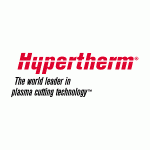NEW INNOVATIONS IN PLASMA CUTTING
Paula Flanders of Hypertherm explains how new materials and torch shapes are increasing the range of plasma cutting applications.
Posted: April 25, 2011
New materials and torch shapes are increasing the range of plasma cutting applications. Here’s how.
Every new technology, from automobiles to televisions, goes through an evolutionary period where the design develops from the early, rudimentary concept to modern, refined, and user-focused. If you think back to your first computer or cell phone, it bore little resemblance to the advanced tablets and smart phones of today.
The torches found on modern plasma cutting systems are no different. The first torches were squared-off, clunky hunks of plastic that looked more like a child’s toy hammer than high-tech cutting equipment. These torches did the trick when plasma cutting was in its infancy, but as plasma cutting and gouging evolved, it became clear that the torches needed to change to withstand harsher conditions and meet a wider variety of needs.
Many people think that the torch is only important as a holder for the consumables. After all, it is the consumables in the torch that make a plasma system work: the electrode carries the charge necessary to create the plasma from the power supply; the swirl ring forces the flow of the resulting plasma into a vortex; and a nozzle constricts and directs the plasma until it is focused enough for cutting.
Indeed, most of the early technology development centered around improving consumable design for increased ease of use and efficiency. For example, in the late 1980s the introduction of blowback torch technology eliminated the need for high-frequency starts and the advent of shielded nozzles enabled the operator to drag the torch directly on the metal being cut (now commonly called drag-cutting).
Operators saw immediate benefits from these technological improvements. Contact-start systems eliminated interference with other shop equipment, while drag-cutting resulted in smoother, easier cuts that allowed users to follow a straight edge or template. Other improvements focused on safety, like the addition of a safety trigger to eliminate accidental torch firing and a “parts-in-place” circuit to ensure consumables were properly installed before firing the torch.
The addition of quick-disconnects, such as the one-button FastConnect™ found on newer Powermax systems, gave operators the ability to quickly swap torches or to remove the torch when transporting the power supply. But even after all these improvements, the shape and bulk of plasma torches remained the same, limiting their use to certain applications. Making radical changes to this traditional design, would require a whole new engineering approach.
That new approach came from a group of plasma engineers that was determined to re-think torch design. And they knew the best way to understand the challenges their customers faced, was by visiting them and watching them work. Over the next year, engineers and product managers logged hundreds of hours on the road, talking to numerous customers during visits to scrap yards, ship yards, and any other high-use cutting environment they could find. Their goal was to find out how well current plasma torches performed in tough conditions and to see firsthand what operators wanted to do with plasma but couldn’t because of current design limitations.
What they heard and observed is that plasma torches, especially hand torches, take a lot of abuse. It wasn’t uncommon to see torches accidently falling off scaffolding, getting banged against metal plan, or seared by the heat of cutting and gouging. During their visits, the engineers also learned that there were a lot of jobs that operators couldn’t do with a standard 90 deg plasma hand torch or full-length mechanized torch.
Although these engineers had plenty of ideas, they focused on three areas: (1) creating a torch that was more robust than anything on the market, (2) improving handle ergonomics while also improving gouging and cutting access for tight locations, and (3) developing a shorter torch for robotic and pipe cutting applications. Everything, from the materials to the consumable design to the guts of the torch, was up for review. The engineers spent two years prototyping torches and then conducting heat, impact, and cut tests. With testing complete, they set out to find the right material for the torch body.




